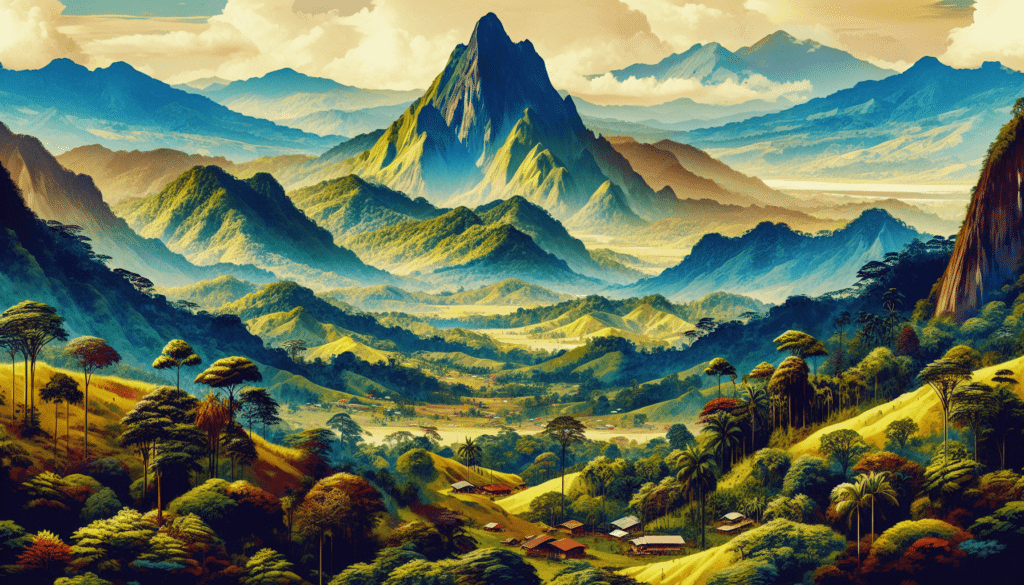Imagine yourself surrounded by breathtaking natural beauty, where lush green foliage stretches as far as the eye can see and towering mountains loom majestically in the distance. Costa Rica, with its magnificent mountains, offers a one-of-a-kind experience for nature enthusiasts and adventure seekers alike. Whether you’re a hiking enthusiast, a photography lover, or simply seeking solace in nature, this ultimate guide will show you the top ways to immerse yourself in the splendor of Costa Rica’s mountains. From adrenaline-pumping activities to serene and picturesque trails, get ready to embark on an unforgettable journey through this awe-inspiring landscape.

The Unparalleled Beauty of Costa Rica’s Mountains
Profile of Costa Rica’s Mountain Range
Costa Rica’s mountain range boasts a diverse and stunning landscape, with towering peaks, lush valleys, and cascading waterfalls. Stretching from the Central Highlands to the border of Nicaragua, these mountains offer unparalleled beauty and outdoor adventure. The highest peak in Costa Rica, Cerro Chirripó, reaches a majestic height of 3,820 meters. Whether you’re an avid hiker, nature lover, or simply seeking breathtaking views, Costa Rica’s mountains are sure to captivate you.
The Importance and Richness of Costa Rican Mountain Biodiversity
Costa Rica’s mountains are not only visually captivating, but they also harbor incredible biodiversity. The diverse ecosystems found at different altitudes support a wide array of plant and animal species. From the cloud forests teeming with orchids and bromeliads to the highland meadows dotted with vibrant wildflowers, the flora of the mountains is a sight to behold. This rich biodiversity provides important ecological services and contributes to the overall health of the country’s ecosystems.
Understanding Costa Rica’s Unique Climate
The mountains of Costa Rica offer a unique climate that varies with altitude. As you ascend, the temperature drops and the humidity increases, creating ideal conditions for cloud forests to thrive. The highlands experience a cooler and more temperate climate, making it a welcome escape from the tropical heat found at lower elevations. The mountains also receive a higher amount of rainfall, contributing to the lush vegetation and abundant water sources. Understanding the climate of Costa Rica’s mountains is essential for planning your visit and ensuring a comfortable and enjoyable experience.
Getting There: Travel Tips to Costa Rica
Optimal Travel Seasons
To make the most of your visit to Costa Rica’s mountains, it’s important to consider the optimal travel seasons. The dry season, which runs from December to April, is generally the best time to explore the mountains. During this period, rainfall is minimal, allowing for clearer skies and better visibility. The months of May to November constitute the rainy season, with heavier rainfall and potentially more challenging hiking conditions. However, the lush green landscapes that emerge during this period offer a unique and enchanting experience.
Packing Essentials for Mountain Travel
When packing for your mountain adventure in Costa Rica, there are a few essential items to consider. Firstly, sturdy hiking boots are a must, as you’ll be traversing various terrains. It’s also advisable to bring lightweight and breathable clothing, including long-sleeved shirts and pants to protect against insects and the sun. Additionally, pack a waterproof jacket and a hat for unpredictable weather conditions. Don’t forget essentials such as sunscreen, a reusable water bottle, insect repellent, and a good quality backpack.
Useful Local Travel Apps and Resources
To enhance your travel experience in Costa Rica’s mountains, there are several local travel apps and resources worth exploring. The Costa Rica Tourism Board offers a comprehensive app that provides information on attractions, hiking trails, and accommodations. The iNaturalist app can help you identify plants and animals you encounter along your journey, allowing for a deeper appreciation of the rich biodiversity. Online platforms such as TripAdvisor and Lonely Planet also offer valuable insights from fellow travelers, helping you make informed decisions during your trip.

The Top Mountain Destinations in Costa Rica
Profiles of Major Mountains
Costa Rica is home to several major mountains that are worth exploring. Cerro Chirripó, the highest peak in the country, offers a challenging but rewarding trek with breathtaking views from the summit. The Arenal Volcano and its surrounding national park provide a unique opportunity to witness volcanic activity while immersing yourself in lush rainforests. The Monteverde Cloud Forest Reserve is a paradise for nature enthusiasts, with its misty trails, abundant wildlife, and stunning canopy walks. Each mountain destination offers its own distinct beauty and adventure.
Hidden Mountain Gems Worth Exploring
While the major mountains may steal the spotlight, Costa Rica is also home to hidden gems waiting to be discovered. The Orosi Valley, nestled in the Central Highlands, is a picturesque region dotted with charming villages, coffee plantations, and mesmerizing waterfalls. The Talamanca Range, located in the southern part of the country, is a remote and pristine wilderness with diverse landscapes and indigenous communities. These hidden mountain destinations offer a more off-the-beaten-path experience and a chance to discover the lesser-known wonders of Costa Rica’s mountains.
Top Mountain Towns and Villages
For a taste of local culture and a close connection with the mountains, visiting the charming mountain towns and villages is a must. Santa Elena, located near the Monteverde Cloud Forest Reserve, offers a delightful blend of eco-tourism initiatives and a vibrant arts and crafts scene. Dominical, on the southern Pacific coast, provides easy access to the mountains and stunning beaches, making it a popular destination for outdoor enthusiasts. The town of Zarcero, with its beautifully manicured topiary gardens, offers a unique and tranquil mountain experience. Exploring these mountain towns and villages allows you to immerse yourself in the local way of life and discover the true heart of Costa Rica’s mountains.
Hiking and Climbing Experiences in Costa Rica’s Mountains
Popular Mountain Trails
Costa Rica’s mountains are a haven for hiking enthusiasts, offering a wide range of trails suitable for all skill levels. The Chirripó National Park boasts the iconic Chirripó Grande hike, a challenging multi-day trek that rewards hikers with breathtaking panoramic views from the summit. The Monteverde Cloud Forest Reserve offers shorter trails that meander through misty forests and lead to stunning lookout points. Another popular trail is the Cerro Pelado hike, which takes you through highland grasslands and offers sweeping views of the surrounding mountains. These trails provide opportunities to witness the beauty of Costa Rica’s mountains up close and personal.
General Tips for Safe Mountain Hiking
While exploring the mountains of Costa Rica, it’s important to prioritize your safety. Begin by conducting thorough research on the trails you plan to hike, including difficulty levels and weather conditions. Always let someone know your hiking plans and estimated return time. Carry essential items such as a map, compass, first aid kit, and whistle. Stay hydrated and ensure you have enough food to sustain yourself during the hike. Respect wildlife and stay on marked trails to minimize impact on the fragile ecosystems. By following these general guidelines, you can enjoy a safe and memorable hiking experience in the mountains of Costa Rica.
Spotlight on Climbing Opportunities
For those seeking a more vertical adventure, Costa Rica’s mountains offer exciting climbing opportunities. The Barva Volcano, located in Braulio Carrillo National Park, presents a thrilling challenge for experienced climbers. The diverse volcanic rock formations provide a variety of routes to test your skills. The Cerro de la Muerte, while more accessible, also offers superb climbing experiences, ranging from beginner-friendly ascents to more demanding routes for seasoned climbers. Whether you’re new to climbing or an experienced mountaineer, Costa Rica’s mountains provide a range of exhilarating challenges.

The Spectacular Flora and Fauna of Costa Rica’s Mountains
Biodiversity Overview
Costa Rica’s mountains are renowned for their spectacular biodiversity, showcasing an abundance of plant and animal species. The unique combination of altitude, climate, and ecosystems creates favorable conditions for a wide variety of flora and fauna to thrive. From towering oak trees and colorful bromeliads to rare orchids and vibrant butterflies, the mountains are a paradise for nature enthusiasts. The diverse array of fauna includes jaguars, tapirs, resplendent quetzals, and hummingbirds, among many others. Exploring the mountains of Costa Rica offers a fascinating opportunity to witness the intricate web of life found in these ecosystems.
Noteworthy Plant Species
The mountains of Costa Rica are home to numerous noteworthy plant species, some of which are found nowhere else in the world. The Quetzal Flower, also known as the Costa Rican slipper orchid, is a rare and exquisite orchid that blooms in the misty cloud forests. The Golden Toad, sadly now extinct, was once a symbol of Costa Rican biodiversity and emphasized the importance of protecting these unique habitats. Other notable plants include the Costa Rican bamboo orchid, the emerald palm, and the blueberry mistletoe. These plant species add to the enchanting and diverse tapestry of Costa Rica’s mountain flora.
Highlight of Local Faunas
The faunas found in Costa Rica’s mountains are equally impressive, with a wide range of species to discover and appreciate. The resplendent quetzal, with its vibrant plumage and distinctive calls, is a beloved symbol of the cloud forests. The elusive jaguar, although rarely seen, roams the mountains and represents the apex predator of the region. Colorful hummingbirds, such as the fiery-throated hummingbird and the violet sabrewing, flit among the flowers, adding splashes of beauty to the landscape. The mountains of Costa Rica are a treasure trove of unique and captivating animal life.
Mountain Accommodations in Costa Rica
Mountain Lodges Overview
For those seeking a comfortable and immersive mountain experience, mountain lodges in Costa Rica offer the perfect accommodation. Located amidst stunning landscapes, these lodges provide a cozy retreat after a day of exploration. Many lodges are designed with sustainability in mind, incorporating eco-friendly practices such as solar power and rainwater collection. From luxurious lodges offering panoramic views to rustic cabins nestled deep in the forests, there’s an option to suit every traveler’s preference. Mountain lodges not only provide a comfortable stay but also serve as a gateway to the natural wonders of Costa Rica’s mountains.
Staying at Local Guesthouses
For a more authentic and community-focused experience, staying at local guesthouses in mountain villages is highly recommended. These guesthouses offer a glimpse into the daily lives of the locals and provide opportunities for cultural exchange. Your hosts can offer valuable insights into the mountains’ history, traditions, and local cuisine. From cozy rooms adorned with traditional artwork to homemade meals prepared with locally sourced ingredients, staying at a guesthouse allows you to connect with the local community and create lasting memories.
Camping in the Mountains: Do’s and Don’ts
For adventurous souls looking to truly immerse themselves in the wilderness, camping in the mountains of Costa Rica is an excellent option. However, it’s important to follow a few do’s and don’ts to ensure a safe and responsible camping experience. Do choose designated camping areas and obtain any necessary permits to minimize environmental impact. Pack out what you pack in and leave no trace of your presence. Do respect wildlife and observe from a distance. Don’t build fires unless permitted and practice fire safety precautions if allowed. By adhering to these guidelines, you can embrace the beauty of the mountains while preserving their natural integrity.

Costa Rican Mountain Cuisine
Local Dishes You Must Try
Costa Rican mountain cuisine is a delightful fusion of traditional flavors and fresh, locally sourced ingredients. One must-try dish is the casado, a traditional meal comprising rice, beans, plantains, salad, and a choice of protein such as beef, chicken, or fish. The gallo pinto, a breakfast staple, combines rice and beans seasoned with onions, cilantro, and spices. Other dishes to savor include olla de carne, a hearty meat and vegetable soup, and arroz con pollo, a flavorful chicken and rice dish. Exploring the mountain towns and villages will present ample opportunities to sample these delicious local dishes.
Best Mountain Regions for Food Lovers
While Costa Rica’s mountains offer a taste of delicious cuisine throughout the country, some regions stand out as culinary hotspots. The Central Highlands, with its fertile soils and coffee plantations, are known for their delectable produce and aromatic coffee. The Turrialba region is famous for its gourmet cheeses, made from the milk of grass-fed cows that graze on the mountain pastures. The Orosi Valley, with its organic farms and sustainable agriculture practices, offers a farm-to-table experience that showcases the freshest ingredients. Embark on a gastronomic adventure in these mountain regions and savor the flavors of Costa Rica.
Organic Farming and Sustainability in Food Production
Costa Rica’s mountain regions have embraced organic farming and sustainability practices, contributing to the country’s reputation as an eco-friendly destination. Many farms in the mountains prioritize sustainable agriculture methods, such as crop rotation, natural pest control, and composting. By supporting these organic farms, you can enjoy the freshest and healthiest produce while promoting environmentally friendly practices. Additionally, Costa Rica’s commitment to sustainable coffee production has earned it recognition as a premier coffee-growing nation. Visit sustainable coffee farms in the mountains to learn about the process from bean to cup and savor the rich flavors of Costa Rican coffee.
Art and Culture in the Mountains of Costa Rica
History of Mountain Communities
The mountain communities of Costa Rica have a rich cultural and historical heritage that is worth exploring. Many of these communities were founded centuries ago by indigenous people and have retained their traditions and way of life. The town of Zarcero, for example, has a rich history dating back to the early 19th century, and its unique topiary gardens are an expression of the town’s artistic legacy. Exploring the history of mountain communities provides insights into Costa Rica’s cultural tapestry and the resilience of its people in the face of changing times.
Local Folklore and Traditions
Costa Rica’s mountain communities are steeped in folklore and traditions that have been passed down through generations. These stories often revolve around mystical creatures, such as duendes (sprites) or the Cadejos (mythical dogs), and reflect the close relationship between humans and nature. Traditional festivals and celebrations provide a window into the vibrant cultural fabric of these communities. From the colorful Ox Carts Parade in Zarcero to the mystical Punteadores Festival in Monteverde, there are countless opportunities to immerse yourself in Costa Rica’s folklore and traditions.
Art and Craft of the Mountain Region
The mountains of Costa Rica have inspired a flourishing arts and crafts scene, with local artisans showcasing their creativity and craftsmanship. In towns like Sarchí, known as the birthplace of Costa Rican craftsmanship, you’ll find beautifully painted oxcarts and intricately carved wooden furniture. The art scene in Santa Elena, near Monteverde, is thriving, with galleries showcasing the works of local painters and sculptors. Handmade ceramics, textiles, and jewelry are also popular crafts in the mountain regions. Explore the art and craft scene in Costa Rica’s mountains to discover unique and eye-catching pieces that reflect the beauty and inspiration of the surrounding landscapes.

Responsible Tourism in Costa Rica
Importance of Eco-Tourism
Costa Rica has long been a pioneer in eco-tourism, prioritizing sustainable practices to protect its natural resources. By engaging in responsible tourism, visitors can contribute to the preservation of Costa Rica’s mountain ecosystems and support local communities. Choose accommodations and tour operators that prioritize sustainability, such as those certified by the Certification for Sustainable Tourism program. Respect and follow designated trails, leaving nature as you found it. Support local businesses and craftspeople to ensure the economic benefits of tourism reach the communities directly. By embracing eco-tourism, you become an integral part of the conservation efforts in Costa Rica.
Best Practices for Travelers
To be a responsible traveler in Costa Rica’s mountains, it’s important to adhere to a few best practices. Respect wildlife by observing from a distance and refraining from feeding or approaching animals. Practice responsible waste management by disposing of trash properly and recycling whenever possible. Conserve water and energy by using resources sparingly and opting for eco-friendly accommodations. Support local conservation initiatives through donations or volunteering opportunities. By adopting these practices, you can minimize your environmental impact while maximizing the positive contributions to the local communities and ecosystems.
Organizations Supporting Conservation Efforts
Several organizations in Costa Rica are dedicated to supporting conservation efforts in the mountains and beyond. The Monteverde Conservation League, for example, focuses on preserving the unique cloud forest ecosystem through research and educational programs. The Costa Rican National Parks Foundation plays a crucial role in protecting the country’s national parks, ensuring the sustainability of these important natural areas. By supporting these and other similar organizations, you can contribute directly to the conservation and preservation of Costa Rica’s magnificent mountains for future generations to enjoy.
Planning Your Itinerary
Recommended Duration for Mountain Tours
The duration of your mountain tour in Costa Rica depends on your interests and itinerary. A minimum of three to five days allows for a taste of the mountain experience, with opportunities to explore hiking trails, visit local villages, and immerse yourself in nature. For a more comprehensive adventure, consider dedicating at least one to two weeks to fully appreciate the beauty and diversity of Costa Rica’s mountains. This timeframe allows for a deeper exploration of different mountain regions, including hidden gems and off-the-beaten-path destinations.
Suggested Itineraries for Different Travel Styles
Whether you’re a nature lover, adventure seeker, or cultural enthusiast, Costa Rica’s mountains offer itineraries tailored to your travel style. For nature lovers, a visit to the Monteverde Cloud Forest Reserve, followed by a trek to the summit of Cerro Chirripó, provides a perfect combination of stunning landscapes and rich biodiversity. Adventure seekers can embark on a multi-day hiking and climbing expedition, conquering the highest peaks and exploring remote wilderness areas. Cultural enthusiasts can explore the charming mountain towns and villages, immersing themselves in the local way of life and experiencing traditional festivals. Choose an itinerary that aligns with your interests and get ready for an unforgettable mountain journey.
Tips for Combining Mountain and Beach Destinations
Costa Rica’s mountains and beaches offer contrasting yet equally captivating experiences. To combine these two destinations in your itinerary, it’s essential to consider transportation logistics and time allocation. Start by deciding whether to begin with the mountains or the beach, depending on your preferred order of activities. Allocate enough time for each destination, balancing the desire for exploration and relaxation. Consider domestic flights or private transfers for efficient travel between mountains and beach towns. By carefully planning and balancing your time, you can experience the best of both worlds and create a well-rounded Costa Rican adventure.
In conclusion, Costa Rica’s mountains offer unparalleled beauty, biodiversity, and outdoor adventures for travelers from all walks of life. From the towering peaks to the hidden gems, there are countless opportunities to explore and appreciate the magnificence of nature. By embracing responsible tourism practices and supporting local initiatives, you can contribute to the preservation of Costa Rica’s natural treasures. Plan your itinerary wisely, pack your bags with essentials, and prepare for an unforgettable journey through the breathtaking mountains of Costa Rica.







0 Comments